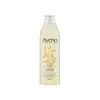What's inside
What's inside
 Key Ingredients
Key Ingredients

No key ingredients
 Benefits
Benefits

 Concerns
Concerns

 Ingredients Side-by-side
Ingredients Side-by-side

Parfum
MaskingCitral
PerfumingLimonene
PerfumingCinnamyl Alcohol
PerfumingCitronellol
PerfumingHydroxycitronellal
PerfumingBenzyl Alcohol
PerfumingGeraniol
PerfumingLinalool
PerfumingPhenoxyethanol
PreservativeSodium Acrylates/C10-30 Alkyl Acrylate Crosspolymer
Oleic Acid
EmollientArachidic Acid
CleansingMyristic Acid
CleansingPEG-100 Stearate
Stearic Acid
CleansingPalmitic Acid
EmollientGlyceryl Stearate
EmollientCera Microcristallina
Emulsion StabilisingGlycerin
HumectantLanolin Alcohol
EmollientMyristyl Alcohol
EmollientParaffinum Liquidum
EmollientWater
Skin ConditioningParfum, Citral, Limonene, Cinnamyl Alcohol, Citronellol, Hydroxycitronellal, Benzyl Alcohol, Geraniol, Linalool, Phenoxyethanol, Sodium Acrylates/C10-30 Alkyl Acrylate Crosspolymer, Oleic Acid, Arachidic Acid, Myristic Acid, PEG-100 Stearate, Stearic Acid, Palmitic Acid, Glyceryl Stearate, Cera Microcristallina, Glycerin, Lanolin Alcohol, Myristyl Alcohol, Paraffinum Liquidum, Water
Water
Skin ConditioningSodium Laureth Sulfate
CleansingCocamidopropyl Betaine
CleansingLauryl Glucoside
CleansingPEG-12 Dimethicone
Skin ConditioningPEG-120 Methyl Glucose Trioleate
CleansingPropylene Glycol
HumectantAvena Sativa Kernel Extract
AbrasiveParfum
MaskingPhenoxyethanol
PreservativeMelaleuca Alternifolia Leaf Oil
AntioxidantEthylhexylglycerin
Skin ConditioningHexyl Cinnamal
PerfumingBenzyl Salicylate
PerfumingLinalool
PerfumingAmyl Cinnamal
PerfumingHydroxyisohexyl 3-Cyclohexene Carboxaldehyde
MaskingBenzyl Benzoate
AntimicrobialCoumarin
PerfumingWater, Sodium Laureth Sulfate, Cocamidopropyl Betaine, Lauryl Glucoside, PEG-12 Dimethicone, PEG-120 Methyl Glucose Trioleate, Propylene Glycol, Avena Sativa Kernel Extract, Parfum, Phenoxyethanol, Melaleuca Alternifolia Leaf Oil, Ethylhexylglycerin, Hexyl Cinnamal, Benzyl Salicylate, Linalool, Amyl Cinnamal, Hydroxyisohexyl 3-Cyclohexene Carboxaldehyde, Benzyl Benzoate, Coumarin
 Reviews
Reviews

Ingredients Explained
These ingredients are found in both products.
Ingredients higher up in an ingredient list are typically present in a larger amount.
Linalool is a fragrance and helps add scent to products. It's derived from common plants such as cinnamon, mint, citrus, and lavender.
Like Limonene, this ingredient oxidizes when exposed to air. Oxidized linalool can cause allergies and skin sensitivity.
This ingredient has a scent that is floral, spicy tropical, and citrus-like.
Learn more about LinaloolParfum is a catch-all term for an ingredient or more that is used to give a scent to products.
Also called "fragrance", this ingredient can be a blend of hundreds of chemicals or plant oils. This means every product with "fragrance" or "parfum" in the ingredients list is a different mixture.
For instance, Habanolide is a proprietary trade name for a specific aroma chemical. When used as a fragrance ingredient in cosmetics, most aroma chemicals fall under the broad labeling category of “FRAGRANCE” or “PARFUM” according to EU and US regulations.
The term 'parfum' or 'fragrance' is not regulated in many countries. In many cases, it is up to the brand to define this term.
For instance, many brands choose to label themselves as "fragrance-free" because they are not using synthetic fragrances. However, their products may still contain ingredients such as essential oils that are considered a fragrance by INCI standards.
One example is Calendula flower extract. Calendula is an essential oil that still imparts a scent or 'fragrance'.
Depending on the blend, the ingredients in the mixture can cause allergies and sensitivities on the skin. Some ingredients that are known EU allergens include linalool and citronellol.
Parfum can also be used to mask or cover an unpleasant scent.
The bottom line is: not all fragrances/parfum/ingredients are created equally. If you are worried about fragrances, we recommend taking a closer look at an ingredient. And of course, we always recommend speaking with a professional.
Learn more about ParfumPhenoxyethanol is a preservative that has germicide, antimicrobial, and aromatic properties. Studies show that phenoxyethanol can prevent microbial growth. By itself, it has a scent that is similar to that of a rose.
It's often used in formulations along with Caprylyl Glycol to preserve the shelf life of products.
Water. It's the most common cosmetic ingredient of all. You'll usually see it at the top of ingredient lists, meaning that it makes up the largest part of the product.
So why is it so popular? Water most often acts as a solvent - this means that it helps dissolve other ingredients into the formulation.
You'll also recognize water as that liquid we all need to stay alive. If you see this, drink a glass of water. Stay hydrated!
Learn more about Water